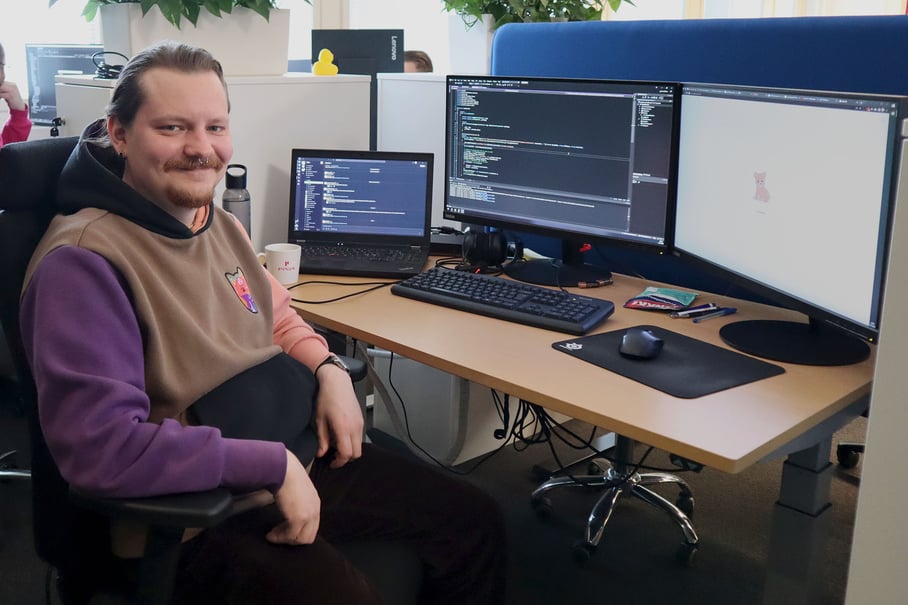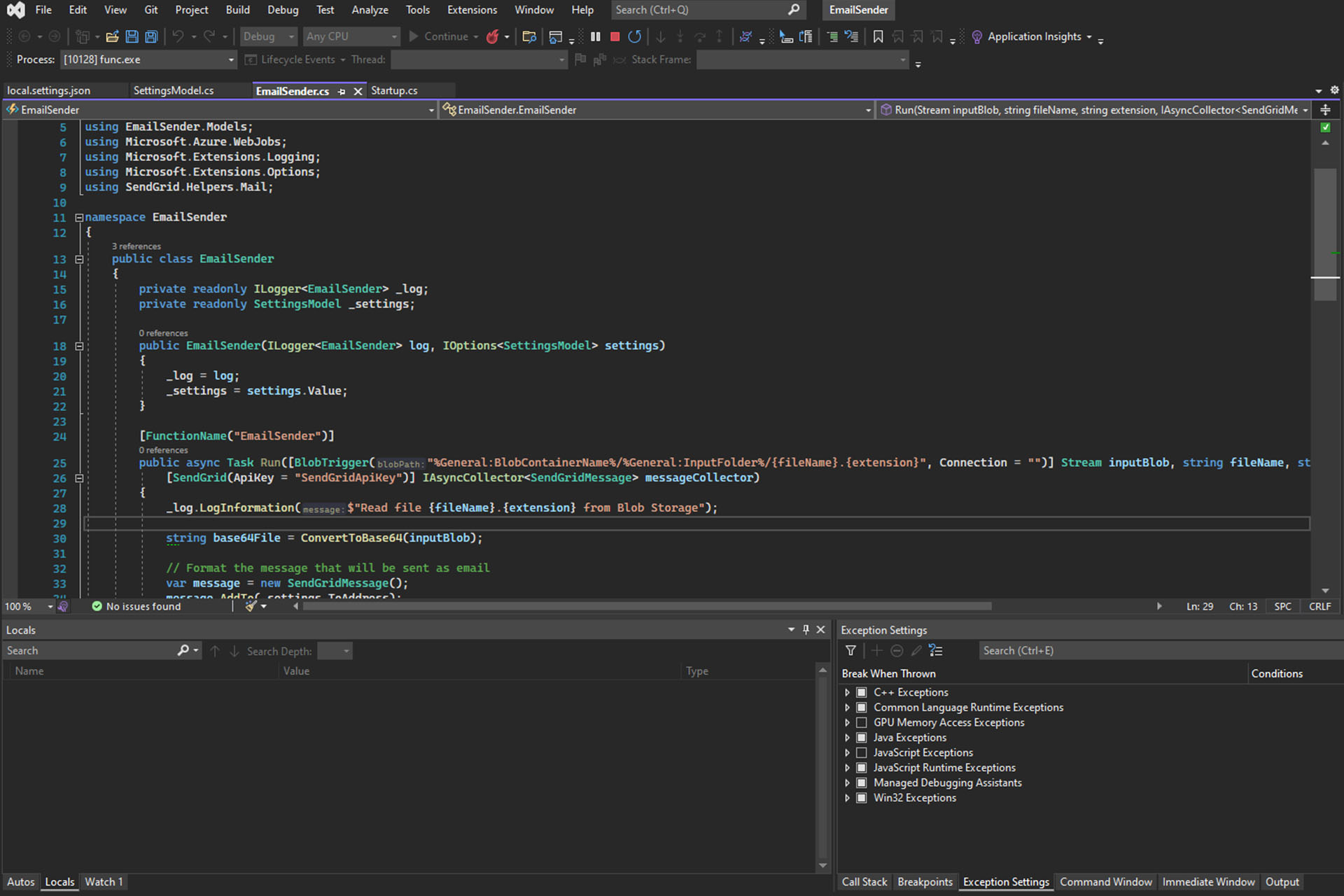
Ilpo is one of Pinja’s experienced back-end developers, specializing in integration development. Ilpo, who works on the IPa by Pinja platform, particularly likes the versatility of his job description. Integrations are designed and implemented for many different clients, in projects of varying scope, and for many different uses. Integrations allow software used for different purposes to communicate smoothly with each other, for example to transfer billing data from a company’s ERP system to the accounting office’s application. This minimizes the need for manual data transfer.
Ilpo found a suitable role for himself in Pinja’s back-end developer task by coincidence. It was at the end of his studies at the Tampere University of Technology when he applied for a job at Pinja in 2017 with an open application. He was a promising young talent so Pinja welcomed him and offered him a position on the integration team, which at the time was in need of additional hands. The position immediately felt natural and familiar to Ilpo.
- I started in a back-end developer role working on integrations, kind of by accident. However, even after several years, I have not felt the need to look for other jobs, Ilpo says.The back-end developer makes data available to the user interface
A back-end developer is a software developer whose work is not directly visible to the end user, but whose input is crucial to the final outcome. Back-end developers do a lot of work on things like the underlying databases and logic of the software, making the data available to the user interface.

- Put simply, our job is to make sure the right data is available in the right place, in the right format. An important part of my work is to think about how to implement the background functionality so that the final solution works as intended, Ilpo explains.
The job description can also vary widely among back-end developers. Some work quite independently and within their own team, while Ilpo’s work also includes customer communication, for example.
- My work on integrations involves a relatively high amount of client communication and client meetings, due to the nature of the job. I think of my role as being more of an architect and definer, while some of my colleagues are more purely developers.
On the client side, the contact persons vary. Sometimes, the contact is with technical experts, while sometimes, especially in the case of smaller client organizations, the contact may not be technically oriented.
- I have to admit that at first, direct client communication didn’t feel very natural to me. But over time I learned to like it – we have such nice clients. When a client contact person is not a technical expert, we need to be able to explain the technical issues in a way that the layperson can understand. Demoing is not quite as easy as on the more visual front. An important part of our work is to be able to explain the different options and possibilities, Ilpo says.Learning on the job through practice
Ilpo, a back-end developer working on integrations, graduated from the Tampere University of Technology with a B.Sc. in technology and a major in software production. As a minor subject, he studied user experience, among other things. Both disciplines have been very useful in his current work, although Ilpo has not done any work directly related to usability so far. However, an understanding of the subject is useful, as back- and front-end developers also work closely together.
Ilpo does not consider knowledge of a particular programming language to be the most important element of the job, but a good basic understanding of the general logic of languages is enough.
Ilpo thinks that his studies gave him a good grounding for working life, but practical work with clients, products, and projects is a different story. The studies included some project courses, but the client interface and a deep understanding of the back-end developer role, for example, only became familiar in the workplace.
- Of course, different people have different ways of learning, but for me the best way to learn is to do practical work. I was assigned a project right from the start, which I took on. The team was a great help, and we started with things like pair coding, where an experienced colleague would stand next to us and tell us exactly what we needed to do, Ilpo recalls.
Ilpo’s current team consists of a project manager and five developers, who work very closely together. Key tools and technologies include the Microsoft Azure portal, C#, and Visual Studio. In addition, SQL and Elasticsearch, among others, are used extensively in the back-end developer role and in the database work on the integration side.
Ilpo does not consider knowledge of a particular programming language to be the most important element of the job, but a good basic understanding of the general logic of languages is enough. It depends more on the subject area of the job what languages coders need for their work. For example, there is not necessarily a significant difference between languages and technologies in front- and back-end work, but what is more important is what is done with the languages.
- The biggest task is in learning the first language, which allows you to learn new languages relatively quickly. My main language used to be Java, now with Azure I use C# the most. It’s a widely used back-end language that also works well with the technologies we use for integrations, such as Azure Functions, Ilpo says.
At Pinja, you can influence your own job description
Ilpo considers Pinja to be a good and fast-growing workplace, which is also easy to join as a new employee. He also appreciates the fact that you can influence your own job description.
- From the very beginning, there has been a relaxed atmosphere and a good spirit at Pinja. There are no cliques, and the discussions are open. Here, you can also influence your own job description, and you’re given more responsibility when ’you're ready for it. Another nice thing is that you can influence the technology choices among the team, Ilpo says.

For Ilpo, the best and most challenging aspects of working on integrations are essentially the same thing; two sides of the same coin.
- My work is varied. I like the fact that there are a lot of projects and therefore a lot of variety in the work. In the course of a week, I work on many different projects, sometimes even during the same day. On the other hand, when moving from one project to another, you also need to be able to change context on the fly.
All in all, Ilpo has found his own development at Pinja to be good, and he intends to continue on the same path in the future.
- My role has evolved enough over the years to keep the work interesting, Ilpo says.
Fact box:
💎 A front-end developer creates the visual side of a website or service, and determines, among other things, the locations and functionality of elements. Technologies used by the front-end developer include Angular, React, Vue.js, and Bootstrap. The most common languages include HTML, CSS, Sass, JavaScript and TypeScript.💎 A back-end developer develops what happens behind the finished product that is visible to the end user. Typically, this includes work on databases and logic, for example. The technologies and languages used by the back-end developer include C#, PHP, Python, Java, ASP.NET and Symfony.
💎 A full-stack developer is a combination of the previous two, i.e., a person who does both front-end and back-end software development. A full-stack developer uses both front-end and back-end software development technologies.
Apply now:
Read more:
A front-end developer develops software from an end user perspective
Pinja enables flexible working models
The “Finnish champion” of web development works at Pinja
Back to the Pinja Blog
Categories
- Pinja Career (67)
- Production development (41)
- Software development (41)
- Business Intelligence (37)
- Digital business (30)
- Circular economy and natural resources (26)
- Sustainability (26)
- Ecommerce (22)
- Digital society (20)
- Industrial digitalization (19)
- Maintenance development (19)
- Supply chain management (19)
- ERP (18)
- ICT services (18)
- Industrial innovation (11)
- Forest industry ERP (9)
- Health and welfare technology (9)
- Lean (4)
